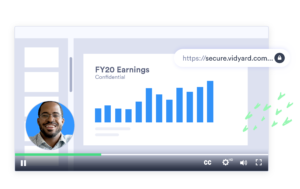 Create videos that engage employees at all levels of the company—quickly, easily, and securely. Learn More
Create videos that engage employees at all levels of the company—quickly, easily, and securely. Learn More 
Using Asynchronous Video to Stay Connected to Remote Staff
Are you feeling video call fatigued? We sure are.
Like many businesses, our team made the shift to working from home in quick succession (it was about 10 hours for us) as the COVID-19 pandemic took hold.
While Zoom is a great tool for having real-time conversations with colleagues and has helped enable our shift to remote work, it still requires a live audience.
And let’s face it, as we learn to effectively work from home, we’re also adapting to changes in our family life. We have kids at home who need the computer to attend online classes. We have a one hour window during the middle of the day in which to pick up our grocery order. I’m hearing from my team that they’re already suffering from being ‘zoomed out.’
So we’ve recognized that the way we approach work also needs to adapt. It’s just not possible for our team to always be available for live meetings. We all need to be a little smarter and more flexible in the way we communicate.
That’s why we’ve started using asynchronous, recorded video to allow our team members to access company information anytime and anywhere.
Let me outline a few of the ways we’re using video and Vidyard to keep employees abreast of news and help them stay connected and informed during this very challenging time.
Put Together a Daily Video News Update
We’ve always been a company that loves video. Even before we went fully remote, every Monday our offices would get together for a start-of-the-week video huddle. It was (at the time) a fairly produced video and we’d plan for it quarterly.
Now, thanks to COVID-19, we’re planning day by day. We don’t have time or the ability to do extensive video editing and production. So we had to learn how to screen record, and our video teams are putting video clips together in a daily news update that serves as a journal for the entire company.
Speed trumps perfect in a crisis, so to get large volumes of news out to our staff in a hurry we use a Vidyard Hub to organize and index the information. This makes the content highly searchable and accessible for staff.
Daily, I also send out a 10-minute video to employees talking about what’s happening in the business and across the company. It’s like my own mini talk show and the response has been incredible. Folks feel like they’re really in touch with what’s going on.
Drive Greater Meeting Efficiency with Recorded Video Updates
While we do continue to use Zoom to host live meetings, we’ve also started using asynchronous video to better prepare for those calls so people’s time is maximized and not wasted. Before each meeting, we’ll pull together a short Google slide deck and shoot a quick video recording to bring everyone up to speed.
We’ve found that those extra steps help cut a one-hour meeting down to 30 minutes because we’re way more focused on outcomes than updates. People can also consume the content on their own time, skip to the important stuff, or replay if necessary.
Use Personal Video to Bring the ‘Human’ Element Back into Communications with Colleagues
Since going fully-remote, we’re also using Slack to help our employees find moments of human-to-human connection. For instance, we’ve set up a channel that allows people to do random coffee chats, just as if they’ve met up ‘at the coffee maker.’
But what video provides that you can’t get from Slack or email is context and body language, which are so vital for conveying empathy and compassion. Video also lends itself to those more relaxed conversations between colleagues.
Everyone is dealing with and reacting to this pandemic uniquely.
Some of our employees are young and in their first job and have never worked remotely before. Other employees are at home alone. Some are finding they’re working too long and too hard because the traditional controls and norms—for instance, a commute to and from the office—aren’t in place. Then you have people who are both working from home and trying to manage schedules and expectations with four kids running around.
I’m very worried about everyone’s mental health right now. I think this virus is going to take its toll in more than one way.
So we’ve been going out of our way to reach out. For instance, I’ll send a personal video message just to let someone know I care about them. It’s our job as leaders to make sure that no one is invisible as we go through this time together.
I like to say that video is the new voicemail. It’s quick. It’s easy. And it’s uniquely personal. It’s also the perfect antidote to video call fatigue and a great answer to some of the communications challenges we’re facing during this pandemic.
We’re being pushed to grow into a different company as we learn to communicate and collaborate in new ways. And I find it interesting to see how video is helping us quickly adapt and adjust to working remotely and to a new normal without the risk of losing that oh-so vital human connection.
About the author:
Greg Malpass is an entrepreneur and the founder and CEO of Traction on Demand, North America’s largest independent Salesforce consulting partner and app development firm.



